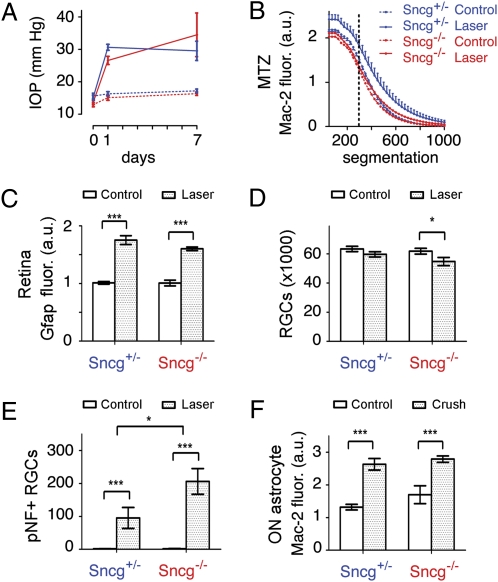Fig. 5.
IOP-dependent Mac-2 increase at the MTZ requires γ-synuclein. (A) γ-Synuclein does not affect the amount of IOP elevation produced by translimbal laser photocoagulation. (B) IOP elevation increases Mac-2 expression at the MTZ in mice with one copy of γ-synuclein (Sncg+/−), but does not do so in mice that lack γ-synuclein (Sncg−/−). For example, at the segmentation value of 300, marked by the dotted line, γ-synuclein genotype affects Mac-2 expression (P = 0.01, two-way ANOVA). SEM shown only for Sncg+/− mice for the sake of clarity, although SEM values were similar for Sncg−/− mice. (C) GFAP fluorescence on the retina surface is increased by lasering equally in Sncg+/− and Sncg−/− mice (***P < 0.001, two-way ANOVA). (D) Number of RGCs is decreased by lasering only in Sncg−/− mice (*P < 0.05, two-way ANOVA with Bonferroni posttest). (E) The number of pNF+ RGCs is increased by lasering in both Sncg+/− and Sncg−/− mice, but moreso in Sncg−/− mice. (*P = 0.03, two-way ANOVA effect of genotype; **P < 0.05 and ***P < 0.001, two-way ANOVA with Bonferroni posttest). (F) The Mac-2 fluorescence increase in optic nerve astrocytes (pixels selected by GFAP expression) observed 3 d after crush is not affected by Sncg genotype (***P < 0.001, two-way ANOVA with Bonferroni posttest). Values represent the mean of eight and six eyes for lasered eyes of Sncg+/− and Sncg−/− mice, five and six eyes for nonlasered control eyes in the lasering experiments, and six and seven eyes for Sncg+/− and Sncg−/− mice in optic nerve crush experiments. Error bars represent SEM.

